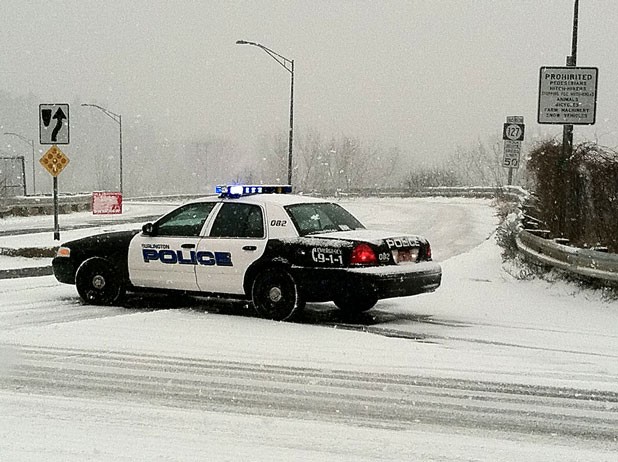
- The south entrance to the Burlington Beltline — while closed
If you routinely drive to and from Burlington via Route 127, you’ve probably encountered, at some time, a police roadblock diverting traffic to North Avenue. Rather than relaxing into your daily dose of Vermont Public Radio as you sail along a scenic stretch of the Winooski River at 50-plus miles per hour, you’re forced to creep along the ave at a snail’s pace. Meanwhile, you wonder what awful accident might have caused this unwanted detour … again.
Envisioning a crash on 127 doesn’t exactly require a vivid imagination. The Burlington Beltline, as the artery running between Manhattan Drive and Malletts Bay is also known, is notorious for speeding and accidents. This is especially true in winter, as evidenced by the sections of chain-link fence that drivers take out on a near-weekly basis.
One particularly problematic spot is the S-curve adjacent to the Ethan Allen Homestead, where the highway narrows from four divided lanes to two undivided ones. Sometime in the last year, an accident investigator spray-painted skid marks across the asphalt leading to a still-missing section of guardrail. Presumably, those lines delineate the trajectory of the poor sucker who failed to negotiate the tight turn, went airborne and ate a mouthful of air bag.
Less than a quarter mile north is the spot where, in 2010, two motorists were killed in a tragic head-on collision. That accident was later blamed on a distracted driver who inadvertently veered across the double yellow line into oncoming traffic.
On January 5 this year, two people landed in the Fletcher Allen emergency room after being struck by a car that skidded on black ice — just as emergency crews were clearing an earlier accident. One of the injured was the driver involved in the first crash, who’d lost control of her car on that same patch of ice; the second victim was her husband, who had just arrived to pick her up. Luckily, neither injury was life threatening.
Burlington police have already logged three Beltline accidents in 2012, including one caused by a dog wandering loose on the road.
“The Beltline is something we regularly close down,” confirms Andi Higbee, deputy chief of operations for the Burlington Police Department. “Even after the salt gets laid down by public works, it still takes a good 20 minutes for that stuff to start working.”
WTF? Why does the Beltline have to close so often? Is this four-mile stretch of highway that much more accident prone than other Vermont roads? Or is it just more noticeable when police shut down a major artery in and out of the city?
The answer is: some of both. In 2011, the Burlington PD documented 32 accidents on the Beltline, including seven that resulted in injuries. In 2010, there were 19 accidents, including three resulting in injuries or deaths. Those stats don’t earn Route 127 an official “death trap” designation but only because the Vermont Agency of Transportation (VTrans) prefers a more sanitized term: HCL, or high-crash location.
HCLs are determined by the total number of crashes, not their severity. VTrans’ most up-to-date statewide list of HCLs covers 2003 to 2007. The list only includes roads eligible for federal highway aid, which means that smaller but equally dangerous town roads may not appear there.
We won’t wade into the formula VTrans uses to calculate the “actual/critical ratio” — the figure that determines which roads and intersections are Vermont’s most accident intensive. Suffice it to say that one stretch of the Beltline, between mile markers 1.3 and 1.5, ranked second worst in the state. Yikes!
In fact, on the 2003-07 list of 131 high-crash locations in Vermont, the Beltline appears five times. One section — the southernmost intersection where the Beltline meets Manhattan Drive — had Vermont’s fifth-highest “severity index,” or highest average cost per crash. This designation, too, comes from a complex formula that factors in such variables as average daily traffic volume, monetary losses per injury or death, and overall property damage suffered.
Nonetheless, Department of Public Works director Steve Goodkind downplays the Beltline’s wreckage rate. Why? He suggests that the perception of frequent closures reflects the fact that Beltline detours are more obvious to drivers than, say, the closure of a single lane on Battery Street. Moreover, Goodkind points out that the Beltline is, by far, Burlington’s fastest-moving road, which means that “when you do have an accident, it can often be more severe and lend itself more to the need to close the road.”
BPD’s Higbee confirms that the police are more inclined to shut down the Beltline entirely than to allow traffic to creep by an accident scene, because closure is safer for emergency responders. And unlike the Queen City’s other accident-prone spots — notably, the Shelburne Road rotary and the intersection of Pearl and Prospect streets — the Beltline is relatively easy to close, because it’s a limited-access highway with a good alternative route.
Still, is there something inherently problematic in the Beltline’s design? Does it need reengineering? Goodkind says no.
“What’s problematic,” he suggests, “is when people are driving too fast [and] not driving for the conditions.”









Comments
Comments are closed.
From 2014-2020, Seven Days allowed readers to comment on all stories posted on our website. While we've appreciated the suggestions and insights, right now Seven Days is prioritizing our core mission — producing high-quality, responsible local journalism — over moderating online debates between readers.
To criticize, correct or praise our reporting, please send us a letter to the editor or send us a tip. We’ll check it out and report the results.
Online comments may return when we have better tech tools for managing them. Thanks for reading.